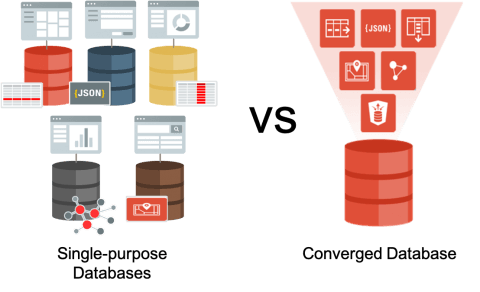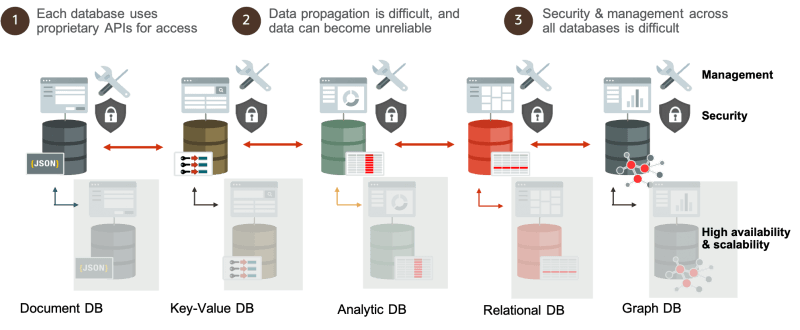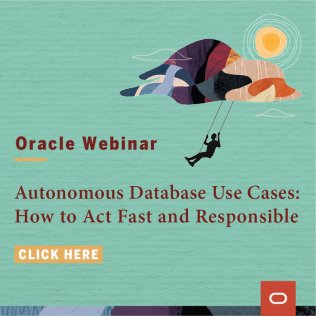
There is an on-going debate in our community about the best approach for developing cloud-native or data-driven apps. On one side, you have folks who say use a single-purpose “best-of-breed” database for each data type or workload you have. While the other half say, you should use a single converged database. So, which approach is right for you and your projects?

Let’s examine some of the pros and cons of each approach.
SINGLE-PURPOSE DATABASES

Single-purpose databases or purpose-built databases as they are often as known, are engineered to help solve a single or small number of problems. Given their narrow focus, they can ignore the tradeoffs usually required when trying to accommodate multiple data types or workloads. It also allows them to use a convenient data model that fits the purpose and to adopt APIs that seem natural for that data model. They offer less functionality than converged databases, and therefore, fewer APIs, making it easier to start developing against them. Their simplicity means they do a few things very well, but other things not at all. For example, a lot of single-purpose databases scale well, because they offer no strong consistency guarantees.
At first glance, single-purpose databases appear to be a good option. Developers are happy because they get exactly what they need to begin a project. However, when you look at the bigger picture, single-purpose databases can cause a lot of pain and end up costing more in the long run.
Very often, development requirements change mid-project, unforeseen business needs crop up, which render the original sound choice of single-purpose database “A”, sadly lacking. This leaves developers with a tough decision. Start from scratch with another single-purpose database to accommodate the new requirements and hoping that no others will surface, or work around the limitations of the original single-purpose database, adding unnecessary complexity to the application code and the maintenance of that code.
Organisations typically have a lot more than just one data type or workload to deal with. What happens when you have numerous single-purpose databases to support all of your business applications? What you quickly realise is that your data has become fragmented across different databases, which use different formats and types and have no direct way to integrate the data between them. How do you manage, secure or integrate such data with other parts of your organisation?

Each single-purpose database is an entirely different database technology, with separate management controls, security models and high availability architectures. Sharing or propagating data across these databases is tricky because there isn’t a shared API.
Unfortunately, your organisation must bear the brunt of the integration work required to make a single-purpose database approach feasible on a large scale. You will need personal who are knowledgeable about the operational aspects of each single-purpose database. Your security policies will have to re-implemented in every database, and your apps will become more complex to deal with propagating data from one database to another. Integrating single-purpose databases has the potential to become a job that never ends.
CONVERGED DATABASE
Converged databases support all data types and workloads. They can also handle any development paradigm, including Microservices, Events, REST, and SaaS, to name just a few. By integrating data types, and workloads as features within a converged database, you can support mixed workloads and data types using a common language (SQL), and a standard set of APIs. You don’t need to manage and maintain multiple systems or worry about having to provide unified security across them.
By eliminating data fragmentation, you also eliminate copy contagion. Application modules or services automatically use a single copy of shared data in a converged database. There are no errors or time delays due to data propagated.
Application code overall becomes more straightforward, as you no longer have to work around the limitations of a single-purpose database or worry about integrating data from multiple sources or propagating data across numerous systems.
You also get synergy across datatypes and workloads. For example, by having support for Machine Learning algorithms and Spatial data in the same database, you can efficiently run predictive analytics on Spatial data. Data-driven app development becomes dramatically more straightforward and faster.
A converged database helps keep things less complicated, which in turn helps reduce the cost of implanting and maintaining your system. It also makes things more reliable.
In the video below, Juan Loaiza and Andrew Sutherland discuss this on-going debate and explain how a converged database makes it easy to develop Data-Driven Apps that enable enterprises to unlock endless possibilities and insights.
Single-purpose “best-of-breed” databases means no vendor lock-in, right?
Unfortunately, that’s not the case. Using a best-of-breed approach creates vendor lock-in, as each single-purpose database has proprietary APIs and transaction models instead of ISO standards like SQL. This fragments development and locks the application into the single-purpose database and very often, the particular cloud vendor providing that database.
It is dramatically simpler for developers to invoke extended SQL to execute ML, graph, spatial, blockchain, IoT and others in one converged database instead of implementing distributed execution and data movement across multiple databases.
But it’s expensive to get started with a Converged Database, right?
The introduction of database cloud services has removed the cost barrier to getting started with a converged database. Oracle Autonomous Database is an excellent example of a converged database. It’s available to developers as part of Oracle Cloud’s Free-Tier or and at a low hourly rate for production or pre-prod environments.
In the long run, organisations save time and money by using converged databases where they can manage all their data types and workloads with only one database technology that caters for all use cases and requirements from different parts of the organisation.
Are there cases where a single-purpose database is the right choice?
As in other industries, there are new or boutique use cases that benefit from single-purpose or specialised products. Especially if the use-case exceeds the limits of a converged database in terms of cost, performance, or scalability, for example, a stock trading system or telephone exchange. These are latency-critical, transaction processing application that require guaranteed microsecond response times and would benefit from being run on Oracle TimesTen.
The use of single-purpose databases should be limited to a small set of very specific tasks.
Oracle Autonomous Data Warehouse provides an easy-to-use, fully autonomous database that scales elastically, delivers fast query performance and requires no database administration. Know more about how how Oracle Autonomous Database can accelerate your business!






